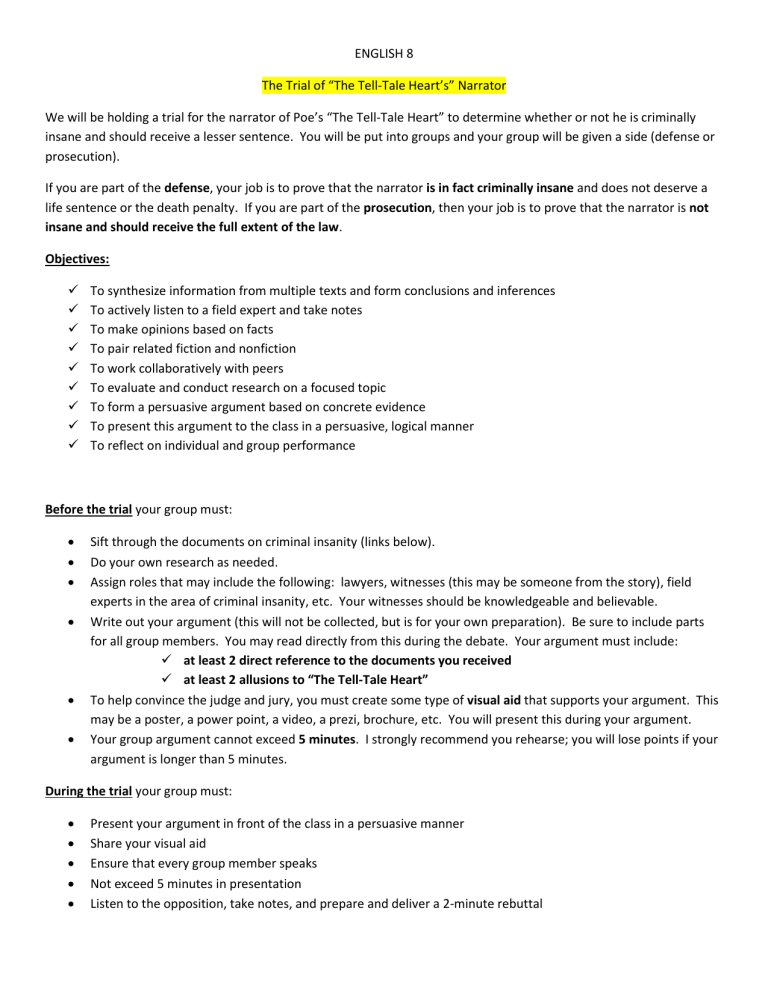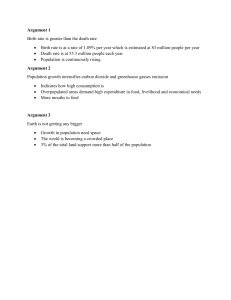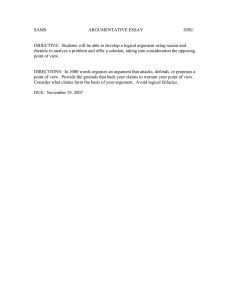
ENGLISH 8 The Trial of “The Tell-Tale Heart’s” Narrator We will be holding a trial for the narrator of Poe’s “The Tell-Tale Heart” to determine whether or not he is criminally insane and should receive a lesser sentence. You will be put into groups and your group will be given a side (defense or prosecution). If you are part of the defense, your job is to prove that the narrator is in fact criminally insane and does not deserve a life sentence or the death penalty. If you are part of the prosecution, then your job is to prove that the narrator is not insane and should receive the full extent of the law. Objectives: To synthesize information from multiple texts and form conclusions and inferences To actively listen to a field expert and take notes To make opinions based on facts To pair related fiction and nonfiction To work collaboratively with peers To evaluate and conduct research on a focused topic To form a persuasive argument based on concrete evidence To present this argument to the class in a persuasive, logical manner To reflect on individual and group performance Before the trial your group must: Sift through the documents on criminal insanity (links below). Do your own research as needed. Assign roles that may include the following: lawyers, witnesses (this may be someone from the story), field experts in the area of criminal insanity, etc. Your witnesses should be knowledgeable and believable. Write out your argument (this will not be collected, but is for your own preparation). Be sure to include parts for all group members. You may read directly from this during the debate. Your argument must include: at least 2 direct reference to the documents you received at least 2 allusions to “The Tell-Tale Heart” To help convince the judge and jury, you must create some type of visual aid that supports your argument. This may be a poster, a power point, a video, a prezi, brochure, etc. You will present this during your argument. Your group argument cannot exceed 5 minutes. I strongly recommend you rehearse; you will lose points if your argument is longer than 5 minutes. During the trial your group must: Present your argument in front of the class in a persuasive manner Share your visual aid Ensure that every group member speaks Not exceed 5 minutes in presentation Listen to the opposition, take notes, and prepare and deliver a 2-minute rebuttal After the trial your group must submit: Your visual aid Each group member must complete an individual reflection describing what he/she learned and whether all group members participated equally. This reflection will be online as a Google Doc and will be graded individually. Each defense team will be paired with an opposing prosecution team. Each pair will be rivaling against each other in the “trial.” At the end of each “trial,” the class (jury) and teacher (judge) will determine which side gave the better argument and is the winner. Winning teams will get a treat! TIMELINE: DAY 1: Learn about assignment; Form groups; brainstorm ideas; start sifting through research packet DAY 2: Work on argument / presentation (Media Center) Begin writing out argument; begin working on visual aid DAY 3: Work on argument / presentation (Media Center) Continue writing out argument; continue working on visual aid DAY 4: Work on argument / presentation (Media Center) Finish writing out argument; finish visual aid; rehearse DAY 5: Final preparation in classroom Final rehearsal DAYS 6-7: TRIALS! TRIAL RUBRIC PLEASE BRING THIS RUBRIC TO THE TRIAL! (In addition to an overall group grade, each student will get an individual classwork grade of 10 points based on his/her performance during workdays. This grade will be based on: staying on task, helping the group as needed, following through with commitments, etc.) GROUP MEMBERS: CONTENT (20 POINTS) PRESENTATION (20 POINTS) EXCEEDS EXPECTATIONS (18-20) Argument is developed logically. At least 2 references to the research documents, and at least 2 references to the story are presented; evidence supports argument; opposition is considered and refuted MEETS EXPECTATIONS (15-17) Consistent eye contact, voice projection at appropriate levels, students demonstrate vocal inflection and confidence; seamless transitions; obvious collaboration between group members; group didn’t go over 5 minutes; visual aid supports argument and shows thought Efforts are made to have eye contact. Message is audible. Students demonstrate some vocal inflection and moments of the delivery show confidence; some transitions; some collaboration between members; group may have gone over 5 minutes; visual aid at times supports argument and shows thought Argument is mostly logical. Evidence somewhat supports argument. Opposition is somewhat considered; some references to research and story, but not enough OVERALL GROUP GRADE FOR PROJECT (out of 40 points): ___________________ COMMENTS: DID GROUP WIN? YES NO DOES NOT MEET EXPECTATIONS (14 or less) Argument is not logical. No references to story or research; evidence does not support argument. No effort to make eye contact. Message is barely audible. Students are monotone and the delivery of argument lacked confidence. Little, if any, collaboration between members; group may have gone over 5 minutes; no visual aid or visual aid lacks thought or insight RESEARCH DOCUMENTS: Document A: About.com: Crime and Punishment http://crime.about.com/od/issues/a/insanity.htm Document B: “The Insanity Defense: A Closer Look” http://www.washingtonpost.com/wpsrv/local/longterm/aron/qa227.htm Document C: “The John Hinckley Trial and Its Effect on the Insanity Defense” http://law2.umkc.edu/faculty/projects/ftrials/hinckley/hinckleyinsanity.htm Document D: “634 Insanity Defense Reform Act of 1984” http://www.justice.gov/usao/eousa/foia_reading_room/usam/title9/crm00634.htm Document E: “The Insanity Defense: History and Background” http://criminal.findlaw.com/criminal-procedure/theinsanity-defense-history-and-background.html




